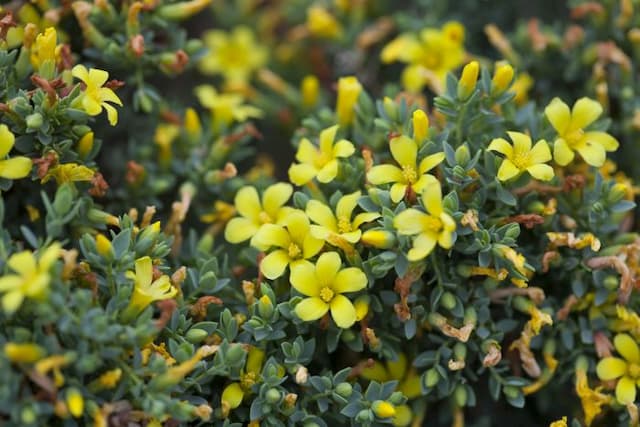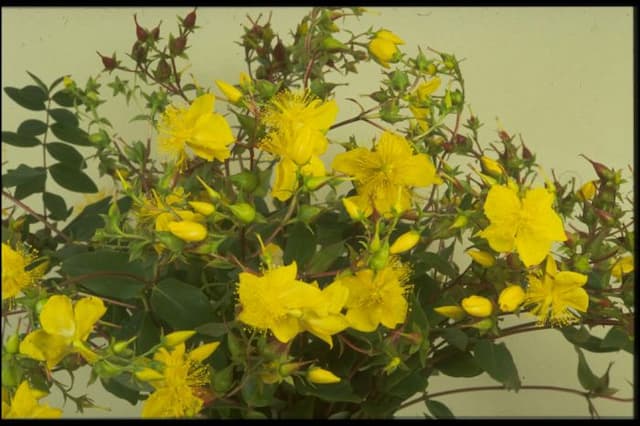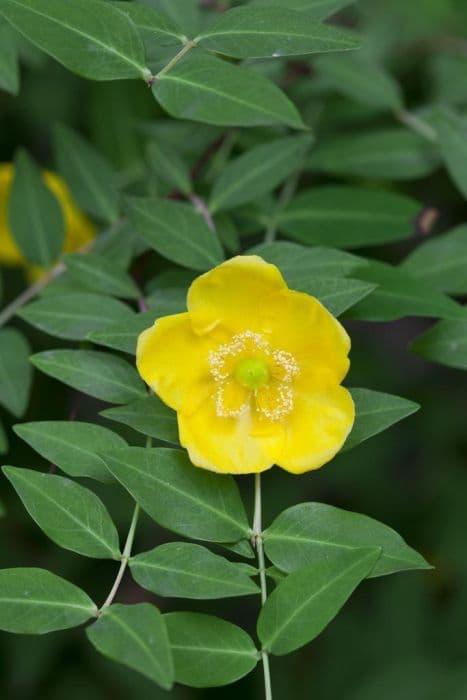Addington's St. John's Wort Hypericum addingtonii

ABOUT
Hypericum addingtonii, commonly referred to as Addington's St. John's wort, is a perennial wildflower with a bushy growth habit. It features elliptical to oblong leaves that are rich green and arranged in opposite pairs along the stems. The leaves often exhibit a slightly wrinkled texture with translucent dots that are visible when held up to the light, a characteristic common to the St. John’s wort family. The plant is adorned with bright yellow flowers that have a distinguished look, each with five, regular-sized, petal-like structures surrounding a prominent, tufted center composed of numerous, yellow-colored, thread-like stamens. These stamens create a halo effect around the central pistil, adding to the flower's ornamental appeal. The blooms are most prolific during the warmer months of the year, typically in late spring through to early fall, and are known for attracting a variety of pollinators, including bees and butterflies. The flowers give way to small, berry-like fruits that are initially green and become reddish or darker as they mature. These seed capsules add interest to the plant even after flowering has concluded. Addington's St. John's wort displays a rugged charm that can enhance naturalized areas, wildflower gardens, and borders. Its showy flowers and attractive foliage make it a valued plant for visual interest in various garden settings without specific reference to its dimensions.
About this plant
 Names
NamesFamily
Hypericaceae
Synonyms
Addington's St. John's Wort
Common names
Hypericum addingtonii.
 Toxicity
ToxicityTo humans
Hypericum addingtonii, commonly known as Addington's St. John's Wort, is not specifically documented as toxic to humans. Members of the Hypericum genus have been used medicinally, but can cause adverse effects in large quantities or sensitive individuals. If any part of the plant were toxic, symptoms might potentially include gastrointestinal upset, confusion, or photosensitivity, as these are common with other Hypericum species. It is always crucial to exercise caution and avoid ingesting plants without certainty of their safety.
To pets
Addington's St. John's Wort is not specifically documented as toxic to pets. However, pets are different in their susceptibility to plant compounds, and some Hypericum species can be toxic to animals. If Hypericum addingtonii were toxic, ingestion might lead to similar symptoms as other toxic Hypericum species such as gastrointestinal upset, lethargy, and possible photosensitivity. It is important to contact a veterinarian if you suspect your pet has ingested any potentially harmful plants.
 Characteristics
CharacteristicsLife cycle
Perennials
Foliage type
Deciduous
Color of leaves
Green
Flower color
Yellow
Height
1-3 feet (0.3-0.9 meters)
Spread
1-2 feet (0.3-0.6 meters)
Plant type
Shrub
Hardiness zones
5
Native area
North America
Benefits
 General Benefits
General Benefits- Ornamental Value: Hypericum addingtonii, also known as Addington's St John's Wort, has vibrant yellow flowers that add aesthetic appeal to gardens and landscapes.
- Habitat Support: It provides food for various pollinators, including bees and butterflies, contributing to the local ecosystem.
- Drought Resistance: As a hardy plant, it can tolerate periods of drought, making it suitable for xeriscaping and dry climates.
- Low Maintenance: This plant generally requires minimal care once established, making it a good choice for those with limited gardening time.
- Soil Erosion Control: Its root system can help stabilize soil, reducing erosion in certain settings.
- Seasonal Interest: With its conspicuous flowers and sometimes colorful autumn foliage, it offers visual interest across multiple seasons.
- Wildlife Shelter: Provides cover for small wildlife, which can use the plant as a form of shelter and a safe place to rest.
- Adaptability: It is able to adapt to a variety of soil types, provided they are well-drained, making it a versatile addition to many garden settings.
- Fragrance: The flowers and leaves may have a subtle fragrance that can be pleasant in the garden or when used in cut flower arrangements.
- Companion Planting: It can be planted alongside other perennials and shrubs to create diverse and supportive plant communities.
 Medical Properties
Medical PropertiesThis plant is not used for medical purposes.
 Air-purifying Qualities
Air-purifying QualitiesThis plant is not specifically known for air purifying qualities.
 Other Uses
Other Uses- Hypericum addingtonii, commonly known as St. John's Wort, can be used as a natural dye due to the presence of hypericin which imparts a red or yellow hue to fabrics and other materials.
- The plant's oil can be infused into candles to create a gentle, calming scent when the candle is burned, lending a relaxing ambiance to a room.
- Dried St. John's Wort can serve as a component in potpourri mixes thanks to its subtle fragrance and attractive, small yellow flowers.
- St. John's Wort is sometimes included in natural insect repellent formulations due to its believed ability to ward off bugs without the use of harsh chemicals.
- The flowers and leaves may be utilized in the creation of natural jewelry, such as pressed flower pendants or botanical resin bracelets.
- Culinary experimentation can incorporate the edible flowers of St. John's Wort as a colorful garnish for salads and desserts, although consumption should be moderate.
- In floristry, St. John's Wort can add an interesting texture and vibrant color to floral arrangements and bouquets.
- Gardeners may cultivate St. John's Wort as a companion plant to deter pests from more vulnerable crops due to its scent and possible insect repellent properties.
- Its dense growth habit makes St. John's Wort suitable for erosion control in some land management practices.
- The plant can play a role in natural landscaping, contributing to a habitat for various pollinators like bees and butterflies with its nectar-rich flowers.
Interesting Facts
 Feng Shui
Feng ShuiThe plant Hypericum, commonly known as St. John's Wort, is not typically used in Feng Shui practice.
 Zodiac Sign Compitability
Zodiac Sign CompitabilitySt. John's Wort is not used in astrology practice.
 Plant Symbolism
Plant Symbolism- Protection: Hypericum, commonly known as St. John's Wort, is often associated with warding off negative influences and protecting against evil spirits.
- Healing: St. John's Wort has medicinal properties and symbolizes the healing of both physical and emotional wounds.
- Strength: The robust nature of the plant, capable of thriving in challenging conditions, is emblematic of inner strength and resilience.
 Water
WaterFor hypericum, also known as St. John's Wort, moderate watering is essential, usually every few days depending on the soil moisture levels. During active growth in the spring and summer, watering may be necessary roughly once or twice a week, ensuring the soil remains moist but not waterlogged. Each watering session should provide enough water to soak the soil to the root level, which might be approximately 1 to 2 gallons depending on the size of the plant and environmental conditions. During the dormant period in the fall and winter, reduce watering frequency to every couple of weeks, or whenever the soil feels dry to the touch a few inches below the surface.
 Light
LightSt. John's Wort thrives best in full sun to partial shade conditions. Ideally, it should receive at least six hours of direct sunlight per day, but it can also tolerate some shade, especially during the hottest part of the day. The best spot for the plant would be in a location where it can enjoy the morning sun, which is less intense and helps to prevent the leaves from scorching.
 Temperature
TemperatureThe optimal temperature range for St. John's Wort is generally between 60 and 70 degrees Fahrenheit, which promotes healthy growth. However, this resilient plant can survive minimum temperatures down to 50 degrees Fahrenheit and can handle summer highs up to around 80 degrees Fahrenheit. Providing a relatively stable temperature within this range will contribute to its flourishing.
 Pruning
PruningPruning St. John's Wort is mainly done to shape the plant and encourage bushier growth. Pruning should be performed once a year, ideally in early spring before new growth starts. Cutting back the stems by about one-third helps to avoid the plant becoming too leggy and encourages the growth of new shoots. Deadheading, or the removal of spent blooms, can be done throughout the flowering season to promote additional blooms and prevent self-seeding if not desired.
 Cleaning
CleaningAs needed
 Soil
SoilHypericum addingtonii, commonly known as St. John's Wort, thrives best in a well-draining soil mix composed of loamy soil, peat, and sand, which helps replicate its natural habitat. The ideal soil pH for St. John's Wort is slightly acidic to neutral, ranging from 5.5 to 7. A mix of two parts loam, one part peat, and one part sand can create a suitable environment for this plant, ensuring good aeration and drainage.
 Repotting
RepottingSt. John's Wort should be repotted every 2 to 3 years, or when it significantly outgrows its current pot. It is best to repot in the spring, just before the growing season begins, to minimize stress on the plant and allow it to establish in the new pot before the main growth period.
 Humidity & Misting
Humidity & MistingSt. John's Wort prefers moderate humidity levels but is quite adaptable and can tolerate a range of conditions. It is not particularly humidity-dependent, making it suitable for typical indoor environments. However, ensuring some air circulation around the plant can help prevent issues with excessive moisture.
 Suitable locations
Suitable locationsIndoor
Ensure bright indirect light and regular watering.
Outdoor
Full sun to partial shade, protect from harsh weather.
Hardiness zone
5-9 USDA
 Life cycle
Life cycleHypericum addingtonii, commonly known as Addington's St. John's Wort, begins its life as a seed, which, after dispersing, requires a period of dormancy before germination can occur. Once conditions are favorable, the seed germinates and sprouts, establishing a root system and sending up shoots to develop into a seedling. As it grows, Addington's St. John's Wort enters a vegetative stage, producing stems, leaves, and developing its characteristic woody structure. Following this, it enters the reproductive stage, characterized by the flowering phase where yellow flowers are produced, attracting pollinators for sexual reproduction. Seeds are formed after successful pollination and are eventually dispersed to start the cycle anew. Seasonal variations and environmental factors may influence the duration and success of these stages throughout the plant's lifecycle.
 Propogation
PropogationPropogation time
Spring to summer
Hypericum addingtonii, commonly known as Addington's St. John's Wort, is often propagated through seed sowing. The best time to sow seeds is either in fall, allowing the cold winter months to naturally stratify them and promote spring germination, or by artificially stratifying the seeds in a refrigerator for about 3 months before sowing them in the spring. To propagate by seeds, you'll first need to collect the seeds from ripe berries of an existing plant. Clean and dry them before the stratification process. After stratification, the seeds can be sown about 1/4 inch deep in well-draining soil and kept moist until germination, which typically takes about 2 to 3 weeks. Once seedlings are strong enough, they can be transplanted to their final growing location, ensuring they have full sun to partial shade and plenty of room to grow.









